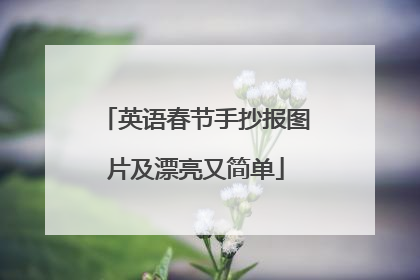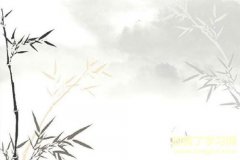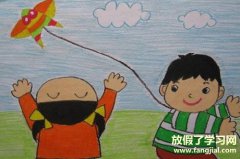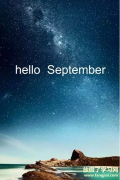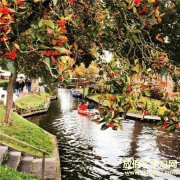春节英语手抄报( Spring Festival)(内容用英语)
What would you do in Spring Festival The Spring Festival like Christmas Day in the western countries, is the most important festival in China. Children like it very much because they can have delicious things to eat, pretty clothes to wear and many nice things to play with. When Spring Festival comes, people away from their hometowns usually come back and spend it with their families. People mainly do two things during the festival. One is eating, and the other is playing. They usually buy different kinds of food and make different kinds of delicious dishes, and play in different ways.In the spirit of setting things straight, all account books should be balanced, debts paid off, and houses cleaned before New Year’s Day. Then houses, businesses, and streets are decked and draped with banners, flowers, and scrolls of vivid red, a traditionally lucky and demon-dispelling hue. People exchange red-wrapped gifts, most commonly the hong bao-cash enclosed in a compact red paper packet-and offer their friends propitious edibles such as red dates (whose Chinese name, hong zao, sounds like the words for “prosperity comes soon”) and tangerines ( whose Cantonese pronunciation, kat, sounds like that of the word for “lucky”).春节习俗春节如西方的圣诞节,是中国盛大的节日。孩子们非常喜欢春节的到来,因为每逢春节,孩子们就会有美味的佳肴,漂亮的衣服,和心仪的玩具。春节期间,无论身在何方的人们都会回到“老家”同家人度过。在这种喜庆的日子里,人们往往做两件事,一是吃好,二是玩好。人们采购各种各样的食物,做着各式各样的美味,用不同方式尽情娱乐。 人们清理房子,结清上年的债务,为了让所有的事情步入正轨,来迎接新的一年。房屋、商店、街道挂上了横幅、种上了鲜花、飘摆着生气勃勃的红色彩带,(红色在中国代表一种喜运与除魔的颜色。人们互送红色包裹的礼物,最普通的是“红包”(将钱装在红色纸袋里),也有人送朋友特殊的食物,如红枣(中文名字“红枣”,意为“红到”)和橘子(它在粤语的发音“kat”音似“福运”)。
Spring Festival Spring Festival known as "new year ", is the Chinese nation most grand traditional festival to celebrate the Spring Festival. Since the Han Dynasty too at the beginning of the first year, with summer year (lunar ) lunar January first " the beginning of the year " (i.e., " year " ), the festival date so fixed, continues to this day. The festival called " New Year's day ". Xin Hai revolution since 1911, began to use the Gregorian calendar (Gregorian calendar ) dating, he called the Gregorian calendar in January 1st as the "New Year's Day ", said the lunar January 1 as "spring festival ". The festival, also known as "traditional festivals ". It has a long history, wide spread, with great popularity, mass, or even universal features. Chinese New Year is the time being. The festival is on lunar January 1, but new year 's activities are not limited to this day of lunar January first. From the twelfth twenty-three ( or twenty-four) of small festivals, people began to "busy ": clean the house, wash bath, preparing for the festival appliances etc.. All of these activities, there is a common theme, namely "new year ". People greet the new year with a grand ceremony and enthusiasm to greet the spring,. Chinese New Year is also offering hope for the day. The Tani Koichi as a " year ", " big grain harvest for years ". The early Western Zhou Dynasty, that has appeared once a year 's harvest celebrations. Later, heaven Qinian became one of the main contents of the vulgar. Moreover, such as kitchen, God, God, God, God of gods Wells Road, during the festival, all to be human incense. People like to take this opportunity to thank the gods of the attention, and wish to receive more blessings in the new year. Chinese new year or family reunion, nearby such day. New year's Eve, the whole family have a joyous gathering, eat "reunion dinner ", elders give children distribute " gift money ", one family tuanzuo " staying-up ". Yuan day over years time, firecrackers chime, bid farewell to the old year, and welcome the new year activity to the climax. The incense to salute, respect for nature, offering fathers, and then to the elders pay New Year's call, and his relatives and friends to congratulate each other. The first day of the year, began to visit relatives and friends, to send each other gifts, in the new year. Chinese New Year is the populace entertainment Carnival festival. The first day of the year, all kinds of rich and colorful entertainment to carry out activities: play the lion, dragon dance, yangko dance, walking on stilts, juggling the play, to celebrate the Spring Festival add rich festive atmosphere for the spring festival. At this time, when the " beginning" before and after, it will have a big spring ceremony, whip Niu Yingchun, for favorable weather, bumper grain harvest. All kinds of activities to the lunar January fifteen, formed the climax again. Therefore, set for, celebrations, entertainment for the whole of the festival festival became the most grand holiday of the Chinese nation. Today, in addition to sacrifice ancestor worship and other activities than ever before to fade away, the festival's main custom, are in good condition to inheritance and development. The Spring Festival is an important carrier of the excellent traditional culture of the Chinese nation, it contains the wisdom and the crystallization of Chinese culture, condensing Chinese people's life pursuit and emotional reposing, inheritance of Chinese family ethics and social ethics. After thousands of years of accumulation, colorful folk customs of the Spring Festival, has formed a profound and unique culture of the spring festival. In recent years, with the improvement of living standards, people demand for spiritual and cultural life of the rapid growth, more intense affection, friendship, harmonious, happy desire, the Spring Festival is a traditional festival has attracted more and more attention from all sectors of society and attention. We should vigorously promote the Spring Festival by the condensation of excellent traditional culture, highlight the new year reunion, blessing of peace, prosperity, and strive to create a harmonious family, stability and unity, joy and harmony in the festive atmosphere, to promote Chinese culture, its development. There used to be called the "year " monster, head long sharp edges, fierce abnormalities, and live in the sea. On New Year's Eve night climbed out, spit food livestock harm his life. Therefore, a new year's Eve, everyone fled to the mountains, to avoid "year ". This year, from the village to a silver to be elegant, eye Ruolang star old man. The middle of the night " year" beast into the village, are ready to act violently when, suddenly heard " crackling sound of bombing ", the old man put on robes in front of " year ", " year" trembling, fled back to the sea, then the night did not dare to the village. This is the legend of the origin and have the Spring Festival fireworks, after several years of development, have the Spring Festival custom Yuelai more rich.
阿斯顿发给寒假快乐
Spring Festival Spring Festival known as "new year ", is the Chinese nation most grand traditional festival to celebrate the Spring Festival. Since the Han Dynasty too at the beginning of the first year, with summer year (lunar ) lunar January first " the beginning of the year " (i.e., " year " ), the festival date so fixed, continues to this day. The festival called " New Year's day ". Xin Hai revolution since 1911, began to use the Gregorian calendar (Gregorian calendar ) dating, he called the Gregorian calendar in January 1st as the "New Year's Day ", said the lunar January 1 as "spring festival ". The festival, also known as "traditional festivals ". It has a long history, wide spread, with great popularity, mass, or even universal features. Chinese New Year is the time being. The festival is on lunar January 1, but new year 's activities are not limited to this day of lunar January first. From the twelfth twenty-three ( or twenty-four) of small festivals, people began to "busy ": clean the house, wash bath, preparing for the festival appliances etc.. All of these activities, there is a common theme, namely "new year ". People greet the new year with a grand ceremony and enthusiasm to greet the spring,. Chinese New Year is also offering hope for the day. The Tani Koichi as a " year ", " big grain harvest for years ". The early Western Zhou Dynasty, that has appeared once a year 's harvest celebrations. Later, heaven Qinian became one of the main contents of the vulgar. Moreover, such as kitchen, God, God, God, God of gods Wells Road, during the festival, all to be human incense. People like to take this opportunity to thank the gods of the attention, and wish to receive more blessings in the new year. Chinese new year or family reunion, nearby such day. New year's Eve, the whole family have a joyous gathering, eat "reunion dinner ", elders give children distribute " gift money ", one family tuanzuo " staying-up ". Yuan day over years time, firecrackers chime, bid farewell to the old year, and welcome the new year activity to the climax. The incense to salute, respect for nature, offering fathers, and then to the elders pay New Year's call, and his relatives and friends to congratulate each other. The first day of the year, began to visit relatives and friends, to send each other gifts, in the new year. Chinese New Year is the populace entertainment Carnival festival. The first day of the year, all kinds of rich and colorful entertainment to carry out activities: play the lion, dragon dance, yangko dance, walking on stilts, juggling the play, to celebrate the Spring Festival add rich festive atmosphere for the spring festival. At this time, when the " beginning" before and after, it will have a big spring ceremony, whip Niu Yingchun, for favorable weather, bumper grain harvest. All kinds of activities to the lunar January fifteen, formed the climax again. Therefore, set for, celebrations, entertainment for the whole of the festival festival became the most grand holiday of the Chinese nation. Today, in addition to sacrifice ancestor worship and other activities than ever before to fade away, the festival's main custom, are in good condition to inheritance and development. The Spring Festival is an important carrier of the excellent traditional culture of the Chinese nation, it contains the wisdom and the crystallization of Chinese culture, condensing Chinese people's life pursuit and emotional reposing, inheritance of Chinese family ethics and social ethics. After thousands of years of accumulation, colorful folk customs of the Spring Festival, has formed a profound and unique culture of the spring festival. In recent years, with the improvement of living standards, people demand for spiritual and cultural life of the rapid growth, more intense affection, friendship, harmonious, happy desire, the Spring Festival is a traditional festival has attracted more and more attention from all sectors of society and attention. We should vigorously promote the Spring Festival by the condensation of excellent traditional culture, highlight the new year reunion, blessing of peace, prosperity, and strive to create a harmonious family, stability and unity, joy and harmony in the festive atmosphere, to promote Chinese culture, its development. There used to be called the "year " monster, head long sharp edges, fierce abnormalities, and live in the sea. On New Year's Eve night climbed out, spit food livestock harm his life. Therefore, a new year's Eve, everyone fled to the mountains, to avoid "year ". This year, from the village to a silver to be elegant, eye Ruolang star old man. The middle of the night " year" beast into the village, are ready to act violently when, suddenly heard " crackling sound of bombing ", the old man put on robes in front of " year ", " year" trembling, fled back to the sea, then the night did not dare to the village. This is the legend of the origin and have the Spring Festival fireworks, after several years of development, have the Spring Festival custom Yuelai more rich.
阿斯顿发给寒假快乐
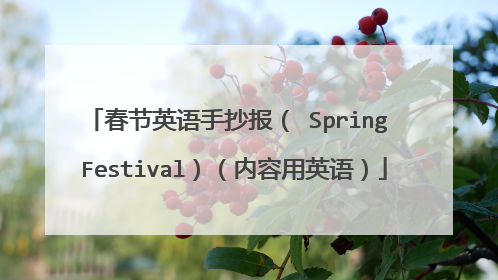
春节的英语手抄报
导语:传说“年”是一种怪兽,它每到除夕之夜都要伤害人们的性命,人们发现它有三怕,怕红色、光、声音。人们就用鞭炮的光、声音和颜色吓跑“年”。 春节的英语手抄报 春节的英语手抄报 春节的英语手抄报 少数民族的春节习俗: 在中国,春节也是各少数民族人民的风俗节日。各族人民按照自已的习俗,举行各种各样的庆祝活动,具有各自浓厚的民族独特风采。 藏族习俗 藏族除夕那天,人们穿上艳丽服装,戴着奇形怪状的假面具,用唢呐、海螺、大鼓奏乐,举行隆重而又盛大的“跳神会”。小伙子们狂舞高歌,表示除旧迎新,驱邪降福。到了新年早晨,妇女们便去背“吉祥水”,预祝新的一年吉祥如意。 彝族习俗 彝族根据彝历选定年节。有的与当地汉族同过春节。有的地区彝族同胞,在门前树立青松,用松针铺地,表示免灾消祸。还有的地区,在节日里杀猪宰羊,吃坨坨肉,人们互相拜访,互赠肉类和馍馍。大年初一早晨,起床的.第一件事就是挑水回家。他们将一碗水和前一天天的水比重量,如新年的水重,就意味着到来的这一年里雨水充足。 壮族习俗 壮族与汉族同时过春节。除夕晚上,要做好节日那天所吃的米饭,称为“压年饭”,有的地区群众称为“吃立节”,壮语为“过晚年”的意思。它预兆来年农业丰收。有的还包制有一尺多长,五六斤重的烷粑,人口少的一家人一顿还吃不完哩!大年初一清早,天还没亮人们就起床,穿上新衣服,燃放爆竹迎新,妇女们都争着到河边或井旁“汲新水”,开始新的一年沸腾的生活。 布依族习俗 布依族除夕之夜全家人通宵达旦地在水塘边守岁。天一亮,姑娘们便争先恐后地打水。谁最先挑回第一担水,谁就是最勤劳、最幸福的姑娘。 羌族习俗 羌族是中华民族大家庭中具有悠久历史的民族之一。现主要聚居在四川阿坝州境内的茂县、汶川、理县以及松潘部分地区。 羌年节于每年农历十月初一举行庆典,一般为3-5天,有的村寨要过到十月初十。按民间习俗,过羌年时还愿敬神,要敬祭天神、山神和地盘业主(寨神)。全寨人要吃团圆饭、喝咂洒、跳莎朗,直到尽欢而散。整个活动仪式由“许”主持,咂酒则由寨中德高望重的长者开坛。节日期间亲朋好友可互道祝贺,相互迎请。 满族习俗 满族分“红、黄、蓝、白”四旗人。春节时,红旗人在门上贴红挂旗,黄旗人在门上贴黄挂旗,蓝旗人在门上贴蓝挂旗,白旗人在门上贴白挂旗。这些挂旗图案优美,色彩鲜艳,象征着一年的吉祥开端。 侗族习俗 侗族春节期间盛行一种“打侗年”(又叫芦笙会)的群众活动。这种活动类似汉族的“团拜”,只不过比“团拜”显得更加欢乐、热烈。这种活动一般是由两个村庄共同商定举办的。两队在广场上正式举行芦笙歌舞比赛。这时两个村庄的观众,伴随着乐曲,翩翩起舞,尽情地欢乐。 白族习俗 云南白族人过年时,有一种叫“放高升”的庆祝活动。所谓“放高升”就是用整棵的大竹子,在竹节里装上火药,点燃以后可以把整个大竹子崩上天空百十丈,成为名副其实的“高升”。有的地区的白族同胞与苗、壮族一样,从春节到元宵节,都在进行“抛绣球”活动。凡接不住绣球的,要赠给对方纪念品,多次失球而又赎不回纪念品的人,就是表示愿允爱情了。 土家族习俗 春节期间,土家族人民要举行隆重的摆手舞会。摆手舞会是土家族比较流行的一种古老舞蹈,包括狩猎、军事、农事、宴会等70多个舞蹈动作,节奏鲜明,动作优美,舞姿朴实,情调健康,不用道具,有着鲜明的民族特色和浓厚的生活气息。 傣族习俗 泼水节是傣族的新年节日,是傣族一年中最盛大的传统节日。谷雨开始那天定为“泼水节”。在三四天的节日里,人们相互泼水,表示洗去身上的陈年旧土,祝福新的一年幸福平安。 黎族习俗 居住在海南岛上的黎族人,每逢春节到来,家家户户都要摆上丰盛的佳肴美酒,全家围坐在一起吃“年饭”;席间全家还要欢唱“贺年歌”。初一、初二、全村青壮年男子,还要举行一次“春节围猎”。这一天的猎物全村共享。有趣的是在分猎物时,先将全部猎物的一半发给第一个击中猎物的射手;另一半由大家平分。孕妇可分得两份,过路人恰巧相遇,也可分得一份。 僳僳族习俗 僳僳族称年节为“盍什”,他们大都做籼米粑、糯米粑和酿水酒,把第一臼舂出的粑粑放少许在桃、李等果树上,祝愿来年硕果累累。云南怒江地区的僳僳族人民,先要给耕牛喂食盐,以表示尊敬耕牛的劳动。青年男女喜欢举行春节打靶比赛。姑娘们把绣好的荷包吊在竹竿上,荷包左右摇动,请小伙子们射击,谁先射落荷包,姑娘们就把美酒作为奖品送到谁的嘴边。 拉祜族习俗 除夕晚上,拉祜族同胞全家人都要沐浴清身,做好翌日的食物。在食物中,特别重视糯米粑粑,除食用外,总要给牛吃一点,关在犁、锄、砍刀等农具上摆上一点,以酬其一年来与主人合作,祝愿新的一年里创造更多的财富。 达斡尔族习俗 居住在东北嫩江两岸的达斡尔族人,农历正月初一早上,男女青年梳妆打扮,先向长辈请安、敬酒、行礼,然后逐户拜年,每家都准备有蒸糕,拜年的人一进门就抢吃蒸糕,据说吃了之后,生产和生活都能“年年高”。 仫佬族习俗 从正月初一到十五,仫佬族的村村寨寨,男女老少都穿上节日盛装,几十人、几百人,乃至几千人聚会在山坡上或赛场里唱山歌,尽情歌唱劳动、生活和爱情。 独龙族习俗 独龙族里唯一的节日就是先在冬腊月的“卡雀哇”节。最隆重的仪式是牛祭天。这天,族长把牛拴在广场中央的木桩上。由青年妇女将链珠挂在牛角上,接着,一位勇猛强壮的小伙子,手持锋利的竹矛,向牛腋部刺去,直到将牛刺倒死去。此刻,人们就跳起“牛锅庄”舞,然后分吃牛肉。 鄂伦春族习俗 在东北的鄂伦春族人,春节早晨,先在家族中依辈份大小斟酒,幼者给长者叩头,平辈则互相请安,初二、初三进行赛马。正月十五美味佳肴。正月十六的早上,要进行相互抹黑脸的活动。青年人给老年人抹黑时要先叩头。 赫哲族习俗 赫哲族的赫哲语“春节”音译为“佛额什克斯”,即大年除夕之意。人们穿上在帽耳、衣领、袖口、裤腿、围裙、鞋面上绣着美丽的花纹、几何图案和花鸟等花边的兽皮等服装。在年节里,一般人家要做“吐火宴”,或用一种野生果“稠李子”制作成饼子,同时摆满鱼、兽类肉等食品。对待贵客,则用杀活鱼,或把鱼条烤熟,用这种“塔拉哈”招待。 基诺族习俗 春节到来,聚居于云南西双版纳的基诺族,口嚼槟榔的老翁扬头打钹,戴大尖帽的老妪低首鸣锣,由周巴(寨父)最先把鼓敲响,男女青年围成一圈徒手跳舞。 高山族习俗 高山族的人们在春节里身着艳丽的民族服装,成群结队欢聚在村边寨头畅饮美酒,并在乐器伴奏下尽情歌舞。有的村寨还举行叉鱼比赛,开展背篓球竿球等体育活动。

以春节为主题的英语手抄报
给你些资料: 1。关于拜年习俗的由来,传说远古时代有一种怪兽,头顶长独角,口似血盆,人们叫它做“年”。每逢腊月三十晚上,它便窜出山林,掠食噬人。人们只好备些肉食放在门外,然后把大门关上,躲在家里,直到初一早晨,“年”饱餐后扬长而去,人们才开门相见,作揖道喜,互相祝贺 The Chinese New Year is traditional festival that China is rich with most the special features.It symbolizes the lunar calendar for old year to end.New year has already start.The people will take leave cold monotonous of winter, greet the organic full of life spring.A" New Year's Day" of Chinese New Year, a 杜 set 卿 says in 《 five candle treasure 典s 》 :" In order to carry the month, January it is a dollar on first day, as well cloud just dynasty, as well a 朔 of cloud."" Dollar" of original meaning is" head", lead the 申 behind in order to" start", because is a year of first day this day, the first day of the spring, the first day of the January, so be called" three dollars";Because is still a year old this day toward, month toward, day toward, so call" three dynasties" again;Again it is the first day of 朔 , so call" a 朔 " again.Wu of Sung explains in 《 the dream beam record 》 from the herding:" The January 朔 day, the New Year's Day that call".《 Say the text solution word 》 medium to" 旦 " word of hermeneutic for" see from the day an up, a, ground also." Meant the sun to just rise from the horizon rising, is a matutinal meaning.Because it means a year of the first morning respectively, the first morning of the January, so call" New Year's Day" and" positive 旦 "s.In addition to above-mentioned title, the Chinese New Year still call" open the year"," begin a new year"," year old of 芳 "," year old of 华 " etc., in many titles with call" New Year's Day" the most widespread, time is most long-last.Because of the previous dynasties style dissimilarity, the season of the New Year's Day place is also different.The style of the Chinese ancient times is a yin and yang to match the 历 , need at the same time in consideration of the position of the sun and moon, past certain New Year's Day, need certain first it is in a certain season, then make selection with this season the close by month of 朔 is the New Year's Day.Because a years old proceeds together with 12 lunar calendar not equal, differ about 11 days, so separate 3 years to need to establish an intercalary month each 2.Far and away the most important holiday in China is Spring Festival, also known as the Chinese New Year. To the Chinese people it is as important as Christmas to people in the West. The dates for this annual celebration are determined by the lunar calendar rather than the Gregorian calendar, so the timing of the holiday varies from late January to early February.To the ordinary Chinese, the festival actually begins on the eve of the lunar New Year's Day and ends on the fifth day of the first month of the lunar calendar. But the 15th of the first month, which normally is called the Lantern Festival, means the official end of the Spring Festival in many parts of the country. Preparations for the New Year begin the last few days of the last moon, when houses are thoroughly cleaned, debts repaid, hair cut and new clothes purchased. Houses are festooned with paper scrolls bearing auspicious antithetical couplet (as show on both side of the page) and in many homes, people burn incense at home and in the temples to pay respects to ancestors and ask the gods for good health in the coming months. "Guo Nian," meaning "passing the year," is the common term among the Chinese people for celebrating the Spring Festival. It actually means greeting the new year. At midnight at the turn of the old and new year, people used to let off fire-crackers which serve to drive away the evil spirits and to greet the arrival of the new year. In an instant the whole city would be engulfed in the deafening noise of the firecrackers. On New Year's Eve, all the members of families come together to feast. Jiaozi, a steamed dumpling as pictured below, is popular in the north, while southerners favor a sticky sweet glutinous rice pudding called nian gao.
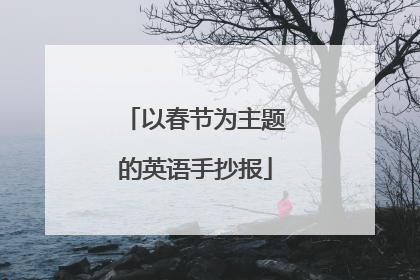
2021英语春节手抄报 2021春节英语手抄报简单好看
导读:在我国,春节就是新年,是正式开启新一年的日子,在迎新之际,我们会准备许多好吃的,然后和家人团聚一起庆祝新年到来,春节期间还有各种各样的活动。那么,2021英语春节手抄报怎么画呢?想要2021春节英语手抄报简单好看图片,可以来瞧瞧我的分享哦。 Why New Year is so special? 为什么新年那么特别呢? The Chinese zodiac features 12 animals in the sequence of Rat, Ox, Tiger, Rabbit, Dragon, Snake, Horse, Sheep, Monkey, Rooster, Dog, and Pig. This year is the year of Tiger. Each animal represents a different "personality". According to legend, people held a conference with all the animals, informing them that they would pick the 12 to represent the zodiac. However, in spite of being fast, the cat was not picked as its then-close friend, the rat, did not wake it. This action sparked off a rivalrythat continues till this day. 中国的十二生肖代表了十二种动物,他们的顺序是:鼠、牛、兔、龙、蛇、马、羊、猴、鸡、狗和猪。今年是虎年。每一种动物有他们自己的“性格”。根据传说,人们当初和动物们开了一个会,最先到会的动物们就可以进入十二生肖。而身为猫最好的朋友,老鼠却没有把猫叫醒去开会。因此,它们之间的战争一直持续到今天。 What do people do? 那人们在新年都干啥呢? Eat, eat again, and then eat some more! As the old Chinese saying goes: food is everything. 吃、接着吃、再吃更多东西!就跟一句中国古话说的那样:食物即一切。 The tradition is to have different main courses everyday from the 1st day of the New Year to the 15th day of the New Year, from Jiao Zi (dumplings), noodles, spring rolls, sticky rice cakes, and Tang Yuan (stuffed rice balls). Besides culinarysatisfaction, each food has a meaning as well: for instance, Jiao Zi looks like gold, implying a wealthy year ahead. 传统就是,从新年第一天开始直到正月十五,每天都要吃不同的主菜。从饺子、面条、春卷、年糕到汤圆。除了祭好五脏庙以外,每一种食物也有含义:比如饺子看起来就像金元宝,这意味来年的丰衣足食。 Besides eating, young people visit older family members and kids are blessed with a red pack of "lucky" money. And then, people gather and eat again (!), leading to a lot of advertisements about fitness right after the Chinese New Year holiday. 除了吃以外,年轻人要去拜会家里的老人家,而小盆友们就有大把压岁钱拿。跟着,人们又聚在一起吃,所以节后中国就会出现很多减肥广告……
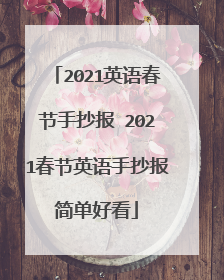
英语春节手抄报图片及漂亮又简单
英语春节手抄报图片大全及漂亮又简单 春节是中国的传统节日,再过些日子中华民族最大的节日春节就快到啦,如果身边有在中国过春节的外国朋友,我们要如何用英语向他们介绍春节呢?下面由我为大家收集的英语春节手抄报,希望可以帮到大家!【春节手抄报图片设计】英语春节手抄报图片1 英语春节手抄报图片2 英语春节手抄报图片3【春节手抄报内容】What does the holiday mean? 这个节日有什么含义吗? The term "pass year" is used for the Spring Festival (Chinese New Year). The word "Year" in Chinese characters used to mean a horrible beast. To combat the beast, the Chinese hang "good luck" wishes on red paper on the door and use fireworks in the belief that the beast fears red and fire. This tradition in many ways resemblethe Western belief of using garlic and crosses to fight vampires. 中文中“过年”这个词组用以表示对春节(中国新年)的庆祝。“年”这个字在中文里是一种恐怖的怪兽。因为“年”害怕红色和火,所以中国人会在门上悬挂“春联”写上美好祝福,并放鞭炮来赶跑它。这个传统有点类似西方人用大蒜和十字架吓跑吸血鬼的传统。 Why New Year is so special? 为什么新年那么特别呢? The Chinese zodiac features 12 animals in the sequence of Rat, Ox, Tiger, Rabbit, Dragon, Snake, Horse, Sheep, Monkey, Rooster, Dog, and Pig. This year is the year of Tiger. Each animal represents a different "personality". According to legend, people held a conference with all the animals, informing them that they would pick the 12 to represent the zodiac. However, in spite of being fast, the cat was not picked as its then-close friend, the rat, did not wake it. This action sparked off a rivalrythat continues till this day. 中国的`十二生肖代表了十二种动物,他们的顺序是:鼠、牛、兔、龙、蛇、马、羊、猴、鸡、狗和猪。今年是虎年。每一种动物有他们自己的“性格”。根据传说,人们当初和动物们开了一个会,最先到会的动物们就可以进入十二生肖。而身为猫最好的朋友,老鼠却没有把猫叫醒去开会。因此,它们之间的战争一直持续到今天。 What do people do? 那人们在新年都干啥呢? Eat, eat again, and then eat some more! As the old Chinese saying goes: food is everything. 吃、接着吃、再吃更多东西!就跟一句中国古话说的那样:食物即一切。 The tradition is to have different main courses everyday from the 1st day of the New Year to the 15th day of the New Year, from Jiao Zi (dumplings), noodles, spring rolls, sticky rice cakes, and Tang Yuan (stuffed rice balls). Besides culinarysatisfaction, each food has a meaning as well: for instance, Jiao Zi looks like gold, implying a wealthy year ahead. 传统就是,从新年第一天开始直到正月十五,每天都要吃不同的主菜。从饺子、面条、春卷、年糕到汤圆。除了祭好五脏庙以外,每一种食物也有含义:比如饺子看起来就像金元宝,这意味来年的丰衣足食。 Besides eating, young people visit older family members and kids are blessed with a red pack of "lucky" money. And then, people gather and eat again (!), leading to a lot of advertisements about fitness right after the Chinese New Year holiday. 除了吃以外,年轻人要去拜会家里的老人家,而小盆友们就有大把压岁钱拿。跟着,人们又聚在一起吃,所以节后中国就会出现很多减肥广告
